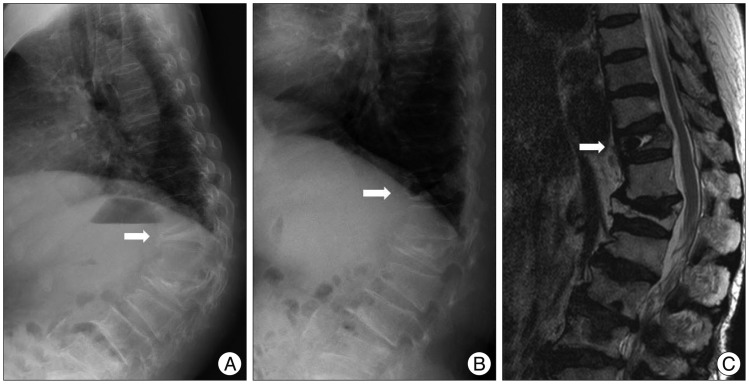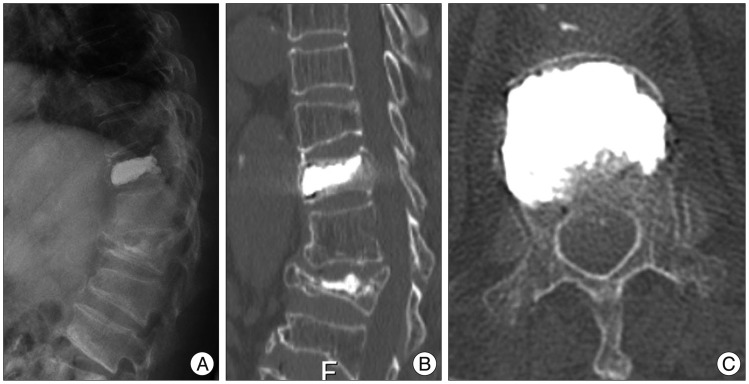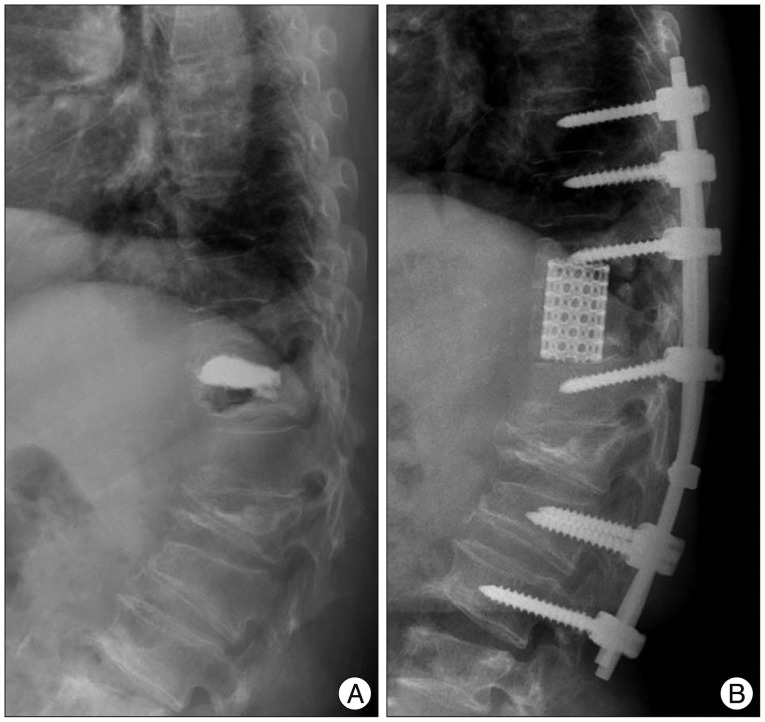J Korean Neurosurg Soc.
2015 May;57(5):367-370. 10.3340/jkns.2015.57.5.367.
Bone Cement Dislodgement: One of Complications Following Bone Cement Augmentation Procedures for Osteoporotic Spinal Fracture
- Affiliations
-
- 1Department of Orthopaedic Surgery, Seoul St. Mary's Hospital, The Catholic University of Korea College of Medicine, Seoul, Korea. boscoa@catholic.ac.kr
- KMID: 1881735
- DOI: http://doi.org/10.3340/jkns.2015.57.5.367
Abstract
- Bone cement augmentation procedures have been getting more position as a minimally invasive surgical option for osteoporotic spinal fractures. However, complications related to these procedures have been increasingly reported. We describe a case of bone cement dislodgement following cement augmentation procedure for osteoporotic spinal fracture by reviewing the patient's medical records, imaging results and related literatures. A 73-year-old woman suffering back and buttock pain following a fall from level ground was diagnosed as an osteoporotic fracture of the 11th thoracic spine. Percutaneous kyphoplasty was performed for this lesion. Six weeks later, the patient complained of a recurrence of back and buttock pain. Radiologic images revealed superior dislodgement of bone cement through the 11th thoracic superior endplate with destruction of the lower part of the 10th thoracic spine. Staged anterior and posterior fusion was performed. Two years postoperatively, the patient carries on with her daily living without any significant disability. Delayed bone cement dislodgement can occur as one of complications following bone cement augmentation procedure for osteoporotic spinal fracture. It might be related to the presence of intravertebral cleft, lack of interdigitation of bone cement with the surrounding trabeculae, and possible damage of endplate during ballooning procedure.
Keyword
MeSH Terms
Figure
Cited by 1 articles
-
Radiological Results of the Double-Balloon Inflation Technique during Kyphoplasty
Dae Ho Ha, Dae Moo Shim, Tae Kyun Kim, Sung Kyun Oh, Seung Min Kim
J Korean Soc Spine Surg. 2018;25(2):41-46. doi: 10.4184/jkss.2018.25.2.41.
Reference
-
1. Boonen S, Wahl DA, Nauroy L, Brandi ML, Bouxsein ML, Goldhahn J, et al. Balloon kyphoplasty and vertebroplasty in the management of vertebral compression fractures. Osteoporos Int. 2011; 22:2915–2934. PMID: 21789685.
Article2. Chen HL, Wong CS, Ho ST, Chang FL, Hsu CH, Wu CT, et al. A lethal pulmonary embolism during percutaneous vertebroplasty. Anesth Analg. 2002; 95:1060–1062. PMID: 12351294.
Article3. Ha KY, Kim KW, Kim YH, Oh IS, Park SW. Revision surgery after vertebroplasty or kyphoplasty. Clin Orthop Surg. 2010; 2:203–208. PMID: 21119935.
Article4. Hashidate H, Kamimura M, Nakagawa H, Takahara K, Uchiyama S. Pseudoarthrosis of vertebral fracture : radiographic and characteristic clinical features and natural history. J Orthop Sci. 2006; 11:28–33. PMID: 16437345.
Article5. He SC, Teng GJ, Deng G, Fang W, Guo JH, Zhu GY, et al. Repeat vertebroplasty for unrelieved pain at previously treated vertebral levels with osteoporotic vertebral compression fractures. Spine (Phila Pa 1976). 2008; 33:640–647. PMID: 18344858.
Article6. Kallmes DF, Comstock BA, Heagerty PJ, Turner JA, Wilson DJ, Diamond TH, et al. A randomized trial of vertebroplasty for osteoporotic spinal fractures. N Engl J Med. 2009; 361:569–579. PMID: 19657122.
Article7. Matsumoto T, Hoshino M, Tsujio T, Terai H, Namikawa T, Matsumura A, et al. Prognostic factors for reduction of activities of daily living following osteoporotic vertebral fractures. Spine (Phila Pa 1976). 2012; 37:1115–1121. PMID: 22158062.
Article8. Mudano AS, Bian J, Cope JU, Curtis JR, Gross TP, Allison JJ, et al. Vertebroplasty and kyphoplasty are associated with an increased risk of secondary vertebral compression fractures : a population-based cohort study. Osteoporos Int. 2009; 20:819–826. PMID: 18797812.
Article9. Mueller M, Daniels-Wredenhagen M, Besch L, Decher C, Seekamp A. Postoperative aseptic osteonecrosis in a case of kyphoplasty. Eur Spine J. 2009; 18(Suppl 2):213–216. PMID: 19089465.
Article10. Oka M, Matsusako M, Kobayashi N, Uemura A, Numaguchi Y. Intravertebral cleft sign on fat-suppressed contrast-enhanced MR : correlation with cement distribution pattern on percutaneous vertebroplasty. Acad Radiol. 2005; 12:992–999. PMID: 16087094.11. Tsai TT, Chen WJ, Lai PL, Chen LH, Niu CC, Fu TS, et al. Polymethylmethacrylate cement dislodgment following percutaneous vertebroplasty : a case report. Spine (Phila Pa 1976). 2003; 28:E457–E460. PMID: 14624094.
- Full Text Links
- Actions
-
Cited
- CITED
-
- Close
- Share
- Similar articles
-
- PHILOS plate fixation with polymethyl methacrylate cement augmentation of an osteoporotic proximal humerus fracture
- Posterior Screw Fixation in Previously Augmented Vertebrae with Bone Cement: Is It Inapplicable?
- Safety and Effectiveness of the Anchor Augmentation with Bone Cement on Osteoporotic Femoral Fracture: A Systematic Reviews
- Percutaneous Iliosacral Screw Fixation with Cement Augmentation in Osteoporotic Sacral Fracture
- The Role of Bone Cement Augmentation in the Treatment of Chronic Symptomatic Osteoporotic Compression Fracture




